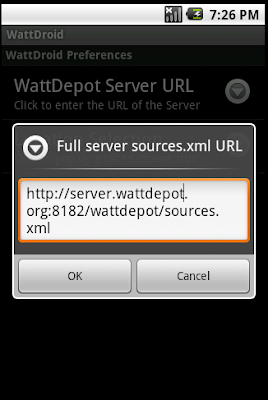Several improvements have been made to WattDroid. We added new features and started to improve the look of the application. A preferences menu is now available to the user. This is where the user is able to specify the WattDepot server URL that they would like to query. The first time WattDroid is run, a prompt asking the user for the server URL is shown. Once a URL is entered, it is stored as a user preference and WattDroid will automatically use this URL, unless the user changes it.
Preferences Menu


Server URL Prompt

The source list was styled to have an image as the background. To accomplish this, the main.xml file for the layout of the page had to be altered. A background referencing an image in the drawable directory was set in the linear layout tag. Other applications have had issues with the image not displaying properly while scrolling. If you are having these issues, check this link which gives an explanation of why it occurs and how to fix the problem.
Styled Source List

The next step for our application is implementing unit testing and automated project building using Hudson. This is important to ensure that changes we make to the project don't adversely affect previously written code. This will be another important aspect of Android development we will have to research and learn.






